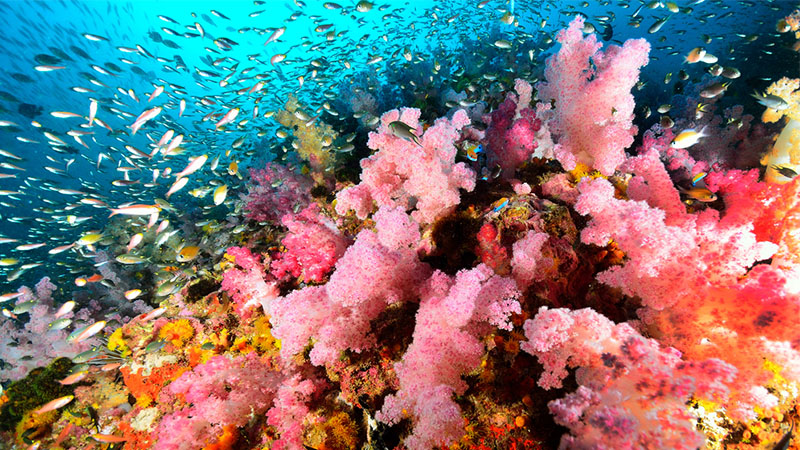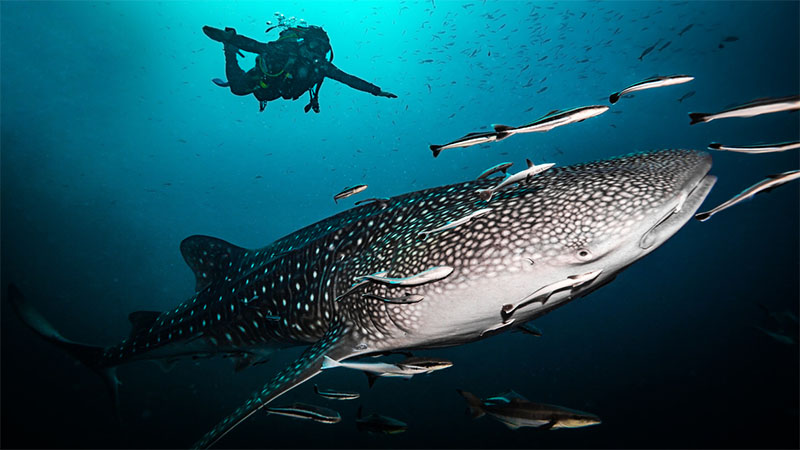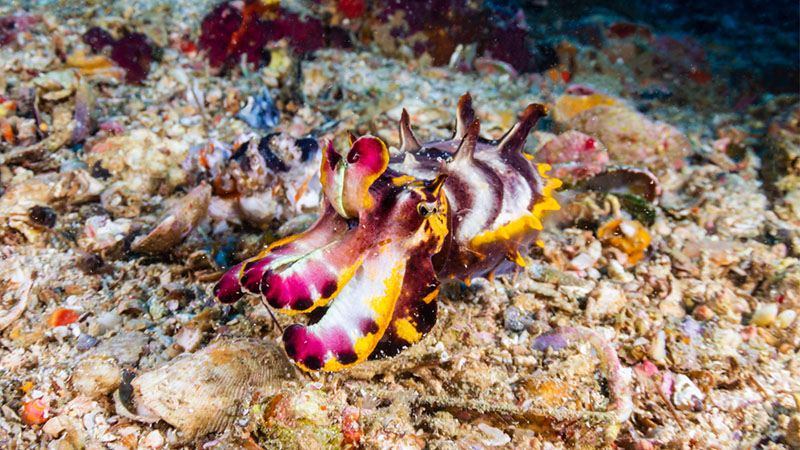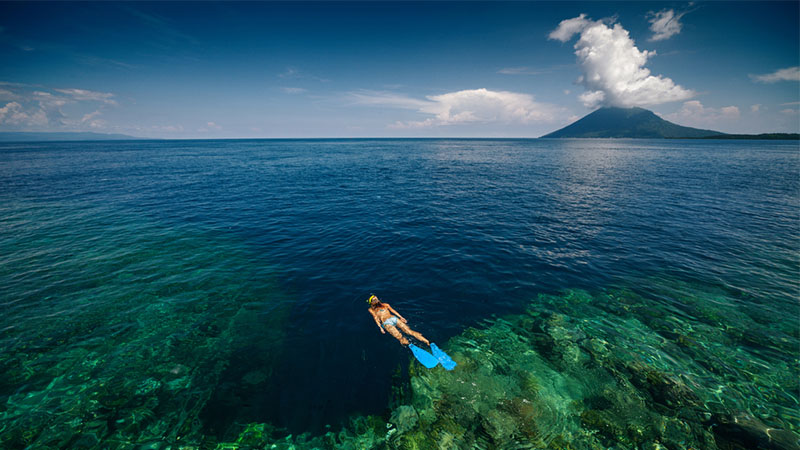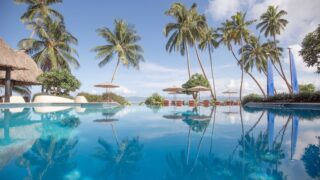Want to know where to go diving in Asia? Get your camera, mask and BCD ready: we’ve got a roundup of a few of the best places to see reefs, wrecks, rays and more.
#1 Similan Islands, Thailand
Named after sembilan, the Malay word for nine (the number of granite islands in the archipelago), the Similan Islands lie 84km north-west of Phuket. Accessible only by boat (usually by liveaboard, though some companies offer day trips via fast speedboat), the islands are virtually uninhabited and the sea life is fantastic. During the dive season from November to May, there are frequent sightings of manta rays and also the occasional whale shark. If you’re on a liveaboard dive boat, go north up to Richelieu Rock, the best dive in the area. On the way, stop at Koh Bon and Koh Tachai for a possible manta experience.
What to see: Manta rays, leopard sharks, barracuda and tropical reef life
Depth: 6m – 30m
Getting there: Bus and boat from Phuket or Khao Lak
#2 Tulamben, Bali, Indonesia
Not dived a wreck before? Check out Liberty, an American Arm Transport Ship that was torpedo by a Japanese sub in the second World War. A relatively simple shore entry (as long as the sea is fairly calm) and the giant barracuda greeting you at the rudder are signs of great things to come. Cruise down the coral-encrusted bow of the wreck with keen eyes or the right guide to spot rare pygmy sea horses or ghost pipefish. On full-moon days there are often mola mola (sunfish) sightings at the wreck, adding another dimension to one of Bali’s most popular dive sites. Whale sharks have also been spotted at the drop-off at the opposite end of the bay.
What to see: US WWII Transport Ship and mola mola
Depth: 6m – 28m
Getting there: 3-hour drive from Seminyak
#3 Candidasa, Bali, Indonesia
Conditions can vary at Candidasa; with strong currents, it’s for advanced divers only but they’ll be rewarded with sightings of some of the bigger marine life like mola mola. Two popular sites are Mimpang and Tepekong islands. Mimpang (Shark Point) is comprised of a series of underwater and out-of-the-water pinnacles. As the name suggests, there are often sharks found lying on the sandy bottom or taking advantage of the current washing over. According to local legend, Tepekong Island was once inhabited by gods who took the form of goats. Luckily these goats stayed munching on dry land and left the island’s waters to thrive. Underwater, the rock formations are dramatic and include a fantastic swim-through that starts at around 26m and goes up to around 18m.
What to see: Reef sharks, mola mola and tropical reef life
Depth: 18m – 26m
Getting there: 90-minute drive from Seminyak
#4 Shark Island, Koh Tao, Thailand
Named after its resemblance to a dorsal fin, Shark Island offers beautiful corals and abundant fish life. As well as the occasional leopard shark, you’ll find blue spotted rays, starry pufferfish and titan triggerfish as well as shoals lingering near “fish junction” on the northern end of the site. The best way to see all sites in and around Koh Tao is to book a place on a liveaboard so you can visit the sites day-trippers don’t dive.
What to see: Leopard sharks, blue spotted rays and tropical reef life
Depth: 5m – 20m
Getting there: Ferry from Koh Samui
#5 Sipadan, Malaysia
You’ll need some patience and a bit of luck to dive the famous Sipadan. The island’s officials only allow 120 divers to visit each day, for one thing. The trick is to book a five-day trip to improve your chances of being granted a permit. The bounty should be worth the wait though, as school barracuda, mating hawksbill and greenback turtles, manta rays, big-eye trevally and hammerhead sharks are waiting. It’s best between April and December when visibility can reach up to 50 metres. Note that, while some rate this as the best diving in Asia, not every traveller’s account of Sipadan is positive, so be sure to do your research before you go.
What to see: Turtles, barracuda, rays, sharks and an abundance of tropical reef life
Depth: 12m – 40m
Getting there: Flight from KL or Kota Kinabalu to Tawau, then 90-minute drive to Semporna
#6 Coron, Palawan, The Phillipines
Diving in Asia isn’t just about marine life. People choose to go to Coron for three reasons: wrecks, wrecks and more wrecks. On 24 September in 1944, American bombers sank 24 Japanese vessels; 12 are dive-able today. The wrecks are intact so diving them feels like visiting an underwater war museum with hard and soft corals benefiting from the carnage.
What to see: Japanese war ship, oil tanker, provision ship and freighters
Depth: 6m – 30m
Getting there: Manila-Busuanga flight then a one-hour drive
#7 Tubbataha, Palawan, The Phillipines
Considered by many as the apex of diving in Asia, Tubbataha Reef Natural Park is a 100,000-hectare marine sanctuary and UNESCO World Heritage Site. Divers can expect an unspoiled array of corals, from seas fans and barrel sponges, to massive fields of hard coral. When it comes to fish life, think big, including huge schools of jacks and barracudas. Turtles and sharks are common, too, with hammerheads making an occasional visit. Being out of the way, Tubbataha diving is done exclusively from liveaboards during the dry months from March to early June and can offer visibility of up to 50 metres.
What to see: A vast expanse of unspoilt tropical marine life and hammerhead and leopard sharks
Depth: 15m – 70m
Getting there: Manila-Puerta Princesa flight then an overnight boat
#8 Monad Shoal, Malapascua, The Philippines
Monad Shoal is one of the only places in the world you are almost guaranteed to spot the long-tailed thresher shark. Home to many cleaning stations, the underwater island on the edge of a 200m drop-off is regularly visited by manta, devil and eagle rays.
What to see: Thresher sharks and manta, devil and eagle rays
Depth: 26m – 200m+
Getting there: Bus and ferry from Cebu
#9 Gato Island, Malapascua, The Philippines
Gato Island regulars say, “You come to Malapascua to see the thresher sharks, but you leave remembering Gato”. The place is teaming with banded sea snakes, cuttlefish (often mating), larger and pygmy seahorses, nudibranchs, frogfish, scorpion fish, porcupine fish, harlequin shrimp and smashing mantis shrimp. Away from the reef you can see schools of squid and big-mouthed mackerel attracted by the baitballs.
What to see: Mating cuttlefish, nudibranch and scorpion fish
Depth: 12m – 30m
Getting there: Bus and ferry from Cebu
#10 Sulawesi, Indonesia
Running along three miles of pristine coastline, this vast network of grass flats and reef drop-offs can be accessed from the Wakatobi island shore. Further out to sea are rich collections of potato coral adorned with anemones and their attendant clownfish. The slopes of the dive site Roma in the South are home to scorpion leaf fish, winged pipe fish, spindle cowries, carpet anemone shrimps and rockmover wrasses. The Eastern Sulawesi waters are full of unusual critters made famous by National Geographic.
What to see: Diverse tropical reef life and fields of pristine corals
Depth: 0m – 40m
Getting there: Chartered flight from Bali through Wakatobi dive resort
For more on diving in Asia and a huge range of holiday ideas, see more in our Travel section.
6 quick getaways from Hong Kong
10 of Asia’s best golf courses
Top things to see and do in Hong Kong

